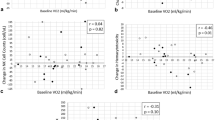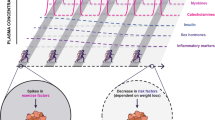Abstract
Purpose
Exercise decreases breast cancer risk and disease recurrence, but the underlying mechanisms are unknown. Training adaptations in systemic factors have been suggested as mediating causes. We aimed to examine if systemic adaptations to training over time, or acute exercise responses, in breast cancer survivors could regulate breast cancer cell viability in vitro.
Methods
Blood samples were collected from breast cancer survivors, partaking in either a 6-month training intervention or across a 2 h acute exercise session. Changes in training parameters and systemic factors were evaluated and pre/post exercise-conditioned sera from both studies were used to stimulate breast cancer cell lines (MCF-7, MDA-MB-231) in vitro.
Results
Six months of training increased VO2peak (16.4 %, p < 0.001) and muscle strength, and reduced resting levels of plasma cholesterol (−18.2 %, p = 0.003) and cytokines. Yet, these systemic adaptations had no effect on breast cancer cell viability in vitro. During 2 h of acute exercise, increases in serum lactate (6-fold, p < 0.001), epinephrine (2.9-fold, p = 0.009), norepinephrine (2.2-fold, p < 0.001), and cytokines, including IL-6 (2.1-fold, p < 0.001) were detected. Incubation with serum obtained after exercise reduced viability by −9.2 % in MCF-7 (p = 0.04) and −9.4 % in MDA-MB-231 (p < 0.001) compared to resting serum.
Conclusion
Systemic changes to a 2 h exercise session reduced breast cancer viability, while adaptations to 6 months of training had no impact. Our data question the prevailing dogma that training-dependent baseline reductions in risk factors mediate the protective effect of exercise on breast cancer. Instead, we propose that the cancer protection is driven by accumulative effects of repeated acute exercise responses.





Similar content being viewed by others
References
Dirx MJ, Voorrips LE, Goldbohm RA et al (2001) Baseline recreational physical activity, history of sports participation, and postmenopausal breast carcinoma risk in the Netherlands Cohort Study. Cancer 92:1638–1649
Fraser GE, Shavlik D (1997) Risk factors, lifetime risk, and age at onset of breast cancer. Ann Epidemiol 7:375–382
Lahmann PH, Friedenreich C, Schuit AJ et al (2007) Physical activity and breast cancer risk: the European Prospective Investigation into cancer and nutrition. Cancer Epidemiol Biomarkers Prev 16:36–42
McTiernan A, Kooperberg C, White E et al (2003) Recreational physical activity and the risk of breast cancer in postmenopausal women: the Women’s Health Initiative Cohort Study. JAMA 290:1331–1336
Patel AV, Callel EE, Bernstein L et al (2003) Recreational physical activity and risk of postmenopausal breast cancer in a large cohort of US women. Cancer Causes Control 14:519–529
Rockhill B, Willett WC, Hunter DJ et al (1999) A prospective study of recreational physical activity and breast cancer risk. Arch Intern Med 159:2290–2296
Tehard B, Friedenreich CM, Oppert JM et al (2006) Effect of physical activity on women at increased risk of breast cancer: results from the E3N cohort study. Cancer Epidemiol Biomarkers Prev 15:57–64
Thune I, Brenn T, Lund E et al (1997) Physical activity and the risk of breast cancer. N Engl J Med 336:1269–1275
Ballard-Barbash R, Friedenreich CM, Courneya KS et al (2012) Physical activity, biomarkers, and disease outcomes in cancer survivors: a systematic review. J Natl Cancer Inst 104:815–840
Brown JC, Winters-Stone K, Lee A et al (2012) Cancer, physical activity, and exercise. Compr Physiol 2:2775–2809
Moore SC, Lee IM, Weiderpass E et al (2016) Association of leisure-time physical activity with risk of 26 types of cancer in 1.44 million adults. JAMA Intern Med 176:816–825
Beasley JM, Kwan ML, Chen WY et al (2012) Meeting the physical activity guidelines and survival after breast cancer: findings from the after breast cancer pooling project. Breast Cancer Res Treat 131:637–643
Bradshaw PT, Ibrahim JG, Khankari N et al (2014) Post-diagnosis physical activity and survival after breast cancer diagnosis: the Long Island Breast Cancer Study. Breast Cancer Res Treat 145:735–742
Chen X, Lu W, Zheng W et al (2011) Exercise after diagnosis of breast cancer in association with survival. Cancer Prev Res 4:1409–1418
Holick CN, Newcomb PA, Trentham-Dietz A et al (2008) Physical activity and survival after diagnosis of invasive breast cancer. Cancer Epidemiol Biomarkers Prev 17:379–386
Holmes MD, Chen WY, Feskanich D et al (2005) Physical activity and survival after breast cancer diagnosis. JAMA 293:2479–2486
Irwin ML, McTiernan A, Manson JE et al (2011) Physical activity and survival in postmenopausal women with breast cancer: results from the women’s health initiative. Cancer Prev Res 4:522–529
Williams PT (2014) Significantly greater reduction in breast cancer mortality from post-diagnosis running than walking. Int J Cancer 135:1195–1202
Alfano CM, Bluethmann SM, Tesauro G et al (2016) NCI funding trends and priorities in physical activity and energy balance research among cancer survivors. J Natl Cancer Inst 108(1):djv285
McTiernan A (2008) Mechanisms linking physical activity with cancer. Nat Rev Cancer 8:205–211
Pedersen BK, Hoffman-Goetz L (2000) Exercise and the immune system: regulation, integration, and adaptation. Physiol Rev 80:1055–1081
Pedersen BK, Steensberg A, Fischer C et al (2001) Exercise and cytokines with particular focus on muscle-derived IL-6. Exerc Immunol Rev 7:18–31
Zouhal H, Jacob C, Delamarche P et al (2008) Catecholamines and the effects of exercise, training and gender. Sports Med 38:401–423
Midtgaard J, Christensen JF, Tolver A et al (2013) Efficacy of multimodal exercise-based rehabilitation on physical activity, cardiorespiratory fitness, and patient-reported outcomes in cancer survivors: a randomized, controlled trial. Ann Oncol 24:2267–2273
Adamsen L, Quist M, Andersen C et al (2009) Effect of a multimodal high intensity exercise intervention in cancer patients undergoing chemotherapy: randomised controlled trial. BMJ 339:b3410
Midtgaard J (2013) Theoretical and practical outline of the Copenhagen PACT narrative-based exercise counselling manual to promote physical activity in post-therapy cancer survivors. Acta Oncol 52:303–309
Durnin JV, Womersley J (1974) Body fat assessed from total body density and its estimation from skinfold thickness: measurements on 481 men and women aged from 16 to 72 years. Br J Nutr 32:77–97
Niles AL, Moravec RA, Eric Hesselberth P et al (2007) A homogeneous assay to measure live and dead cells in the same sample by detecting different protease markers. Anal Biochem 366:197–206
Rogers LQ, Courneya KS, Anton PM et al (2015) Effects of the BEAT cancer physical activity behavior change intervention on physical activity, aerobic fitness, and quality of life in breast cancer survivors: a multicenter randomized controlled trial. Breast Cancer Res Treat 149:109–119
Winters-Stone KM, Dobek J, Bennett JA et al (2012) The effect of resistance training on muscle strength and physical function in older, postmenopausal breast cancer survivors: a randomized controlled trial. J Cancer Surviv 6:189–199
Schmitz KH, Williams NI, Kontos D et al (2015) Dose-response effects of aerobic exercise on estrogen among women at high risk for breast cancer: a randomized controlled trial. Breast Cancer Res Treat 154:309–318
Smith AJ, Phipps WR, Thomas W et al (2013) The effects of aerobic exercise on estrogen metabolism in healthy premenopausal women. Cancer Epidemiol Biomarkers Prev 22:756–764
Campbell KL, Westerlind KC, Harber VJ et al (2007) Effects of aerobic exercise training on estrogen metabolism in premenopausal women: a randomized controlled trial. Cancer Epidemiol Biomarkers Prev 16:731–739
McTiernan A, Tworoger SS, Ulrich CM et al (2004) Effect of exercise on serum estrogens in postmenopausal women: a 12-month randomized clinical trial. Cancer Res 64:2923–2928
Moore SC, Lee IM, Weiderpass E et al (2016) Association of leisure-time physical activity with risk of 26 types of cancer in 144 million adults. JAMA Intern Med 176:816–825
Aoi W, Naito Y, Takagi T et al (2013) A novel myokine, secreted protein acidic and rich in cysteine (SPARC), suppresses colon tumorigenesis via regular exercise. Gut 62:882–889
Hojman P, Dethlefsen C, Brandt C et al (2011) Exercise-induced muscle-derived cytokines inhibit mammary cancer cell growth. Am J Physiol Endocrinol Metab 301:E504–E510
Rundqvist H, Augsten M, Stromberg A et al (2013) Effect of acute exercise on prostate cancer cell growth. PLoS One 8:e67579
Henningsen J (2010) Dynamics of the skeletal muscle secretome during myoblast differentiation. Mol Cell Proteom 9(11):2482–2496
Yu FX, Zhao B, Panupinthu N et al (2012) Regulation of the Hippo-YAP pathway by G-protein-coupled receptor signaling. Cell 150:780–791
Acknowledgments
This work was supported by grants from the Danish Cancer Society, the Danish Cancer Research Foundation, and Dagmar Marshall Fund. The Centre for Physical Activity Research (CFAS) is supported by a grant from TrygFonden. During the study period, the Centre of Inflammation and Metabolism (CIM) was supported by a grant from the Danish National Research Foundation (DNRF55). CIM/CFAS is a member of DD2—The Danish Center for Strategic Research in Type 2 Diabetes (the Danish Council for Strategic Research, Grant No. 09-067009 and 09-075724). Ruth Rousing and Hanne Villumsen are acknowledged for their technical assistance.
Author information
Authors and Affiliations
Corresponding author
Ethics declarations
Conflict of interest
All authors declare no conflicts of interests.
Rights and permissions
About this article
Cite this article
Dethlefsen, C., Lillelund, C., Midtgaard, J. et al. Exercise regulates breast cancer cell viability: systemic training adaptations versus acute exercise responses. Breast Cancer Res Treat 159, 469–479 (2016). https://doi.org/10.1007/s10549-016-3970-1
Received:
Accepted:
Published:
Issue Date:
DOI: https://doi.org/10.1007/s10549-016-3970-1




